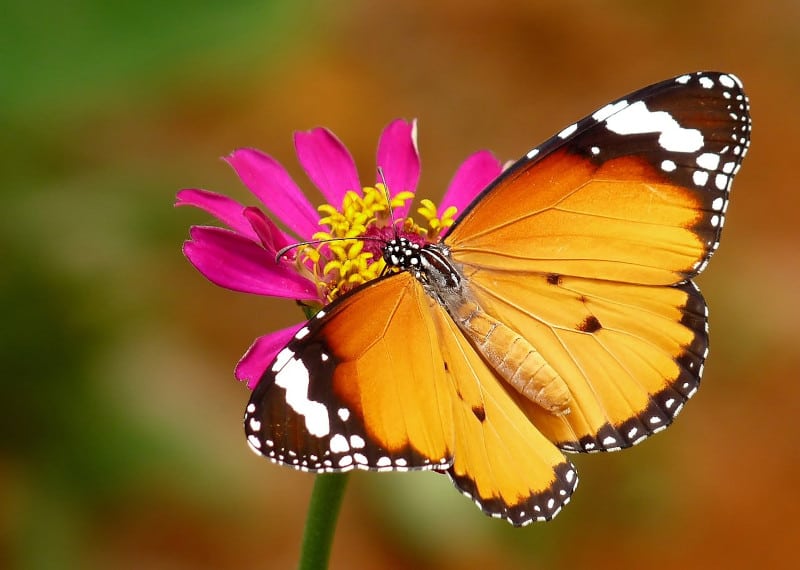African Monarch Facts
- This magnificent Lepidoptera most frequently goes by the descriptive, as well as somewhat informative, common name of the African Monarch. Yet, it also has several alternate names. These include the African queen, and, surprisingly, the plain tiger.
- Scientific professionals, however, such as researchers, typically refer to the invertebrate by its official name. That’s somewhat difficult to pronounce, though, for non-professionals. That’s because it bears the technical moniker of Danaus chrysippus.
- It further received that name due to the efforts of the renowned Swedish researcher, Carl Linnaeus. He accomplished the first formal recognition of the insect as a separate and distinct species. This scientifically noteworthy event occurred in the year 1758.
- Regardless of the term one chooses to use when referring to it, though, it’s a remarkable beauty. A total of three known subspecies also exist. Intriguingly, these share the same range of habitation. It’s truly a marvelous work of Nature and evolution.
- The stunning African Monarch also stands out for another reason. That’s because, unlike many species, it appears to be maintaining a population base that’s both sizeable and stable. This trend further seems to hold true throughout the entirety of its range.
- The IUCN, therefore, presently lists the Arthropod as Least Concern on its Red List. The creature nevertheless faces potential threats to its existence. Habitat loss due to human expansion qualifies as one. Its greatest danger, though, is likely climate change.
Related Articles
African Monarch Physical Description
The remarkable African Monarch impresses those who encounter it with its attributes. Sheer physical size, however, isn’t among the qualities on that particular list. That’s due to the fact that, regardless of its other notable aspects, it ranks as a medium-sized butterfly.
Mature adults attain an average wingspan measuring between 2.8 – 3.1 in (7 – 8 cm). Like many Arthropods, it also displays a slight degree of the physiological characteristic of sexual dimorphism. In its case, though, this trait does not manifest in terms of sheer size.
Males of this insect develop pronounced scent glands, which the female lacks entirely. With the exception of this physical structure, the genders appear virtually indistinguishable. The bodies of both genders also display a basic black shade, with many white spots.
The difference in overall appearance is further augmented, though, by the exact patterns of color. That’s due to the fact that precise combinations vary between individuals, sometimes quite significantly. Certain basic patterns of coloration do remain, however.
Both the upper and lower wings of the African Monarch display a predominantly bright orange hue. On the upperside, the tips of the forewing manifest a black border. White spots also appear there. The hindwing displays the black border, but without the spots.
The underside of the wings also presents a principally orange shade. Here, though, it’s a somewhat lighter shade. The same black border appears, but both wings also have white spots there. The hindwing also presents three small black spots around a central wing cell.
- Kingdom: Animalia
- Phylum: Arthropoda
- Class: Insecta
- Order: Lepidoptera
- Family: Nymphalidae
- Genus: Danaus
- Species: D. chrysippus
African Monarch Distribution, Habitat, and Ecology
Fortunately, for those who appreciate Nature, the dazzling African Monarch apparently evolved as native to a relatively broad swathe of the globe. As the common name itself clearly indicates, this zone of habitation includes virtually the entire continent of Africa.
Its presence isn’t restricted solely to that region of the world, however. That’s because it also appears in an impressive array of other areas. This includes much of Asia, including all of the Indian subcontinent. The insect also appears in Australia, and some Pacific islands!
It further enhances its survival capability by displaying an impressive adaptability in regards to its precise habitat. It does nonetheless demonstrate a preference for one specific type of habitat. The intrepid insect demonstrates a strong fondness for arid, open areas.
Yet, due to its flexibility in terms of where it lives, it also makes appearances in a wide varity of habitats. These include such areas as mountains, deciduous forests, and even deserts and gardens. It seems comfortable at altitudes ranging from sea level to 4,900 ft (1,494 m).
As often happens in Nature, the delicate beauty of the African Monarch conceals a rather surprising secret. Despite its physical fragility, it has few natural predators. That’s due to the fact that its tiny body contains high levels of toxic compounds, called cardenolides.
These originate with its diet. The adults consume nectar from various local flowering plants. The larval form, however, feeds mainly on several plants, but most especially Milkweed. The toxins then accumulate in its body, making it unpalatable to most predators.
Species Sharing Its Range
Check out our other articles on 5 Vividly Vibrant Vines, European Honey Buzzard, Mount Erebus, Gray Fox, Smooth Purple Coneflower, Rough-nosed Horned-Lizard, Eurasian Griffin Vulture

